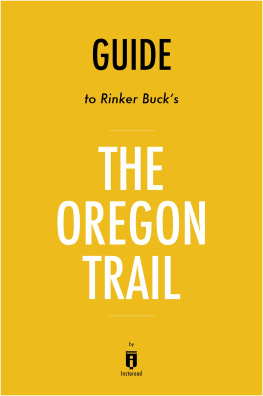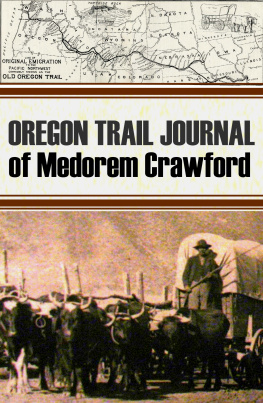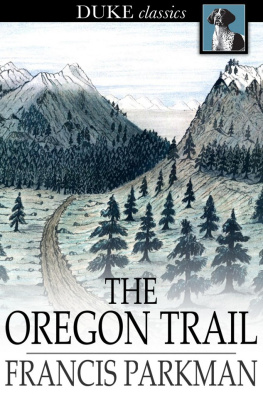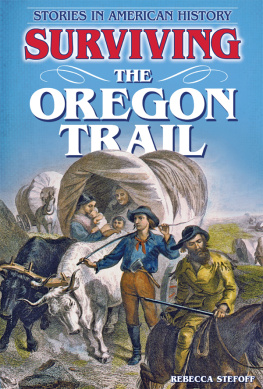This edition is published by BORODINO BOOKS www.pp-publishing.com
To join our mailing list for new titles or for issues with our books borodinobooks@gmail.com
Or on Facebook
Text originally published in 1949 under the same title.
Borodino Books 2017, all rights reserved. No part of this publication may be reproduced, stored in a retrieval system or transmitted by any means, electrical, mechanical or otherwise without the written permission of the copyright holder.
Publishers Note
Although in most cases we have retained the Authors original spelling and grammar to authentically reproduce the work of the Author and the original intent of such material, some additional notes and clarifications have been added for the modern readers benefit.
We have also made every effort to include all maps and illustrations of the original edition the limitations of formatting do not allow of including larger maps, we will upload as many of these maps as possible.
SADDLES EAST
HORSEBACK OVER THE OLD OREGON TRAIL
BY
CHAPLAIN JOHN W. BEARD
IPREPARING FOR THE LONG RIDE
ONE OF THE MOST STIMULATING things about any journey is the preparation for it beforehand. Anticipation may even out-joy realization, and we had almost two years of busy preparation crammed with consuming interest and with enjoyment.
Into my study came two gorgeous saddles, made to order and hand stamped, planned and prepared for the coming ride. They were made by the George Lawrence Company of Portland, Oregon, skilled saddle makers. They were almost a year in the making. They were Western, Do Di Ho, fourteen inches wide, undercut for leg room, cantle three and one-half inches high with Cheyenne Roll, three-quarter rigged, with dees laced in. In short, they were and are the very perfection of the saddle makerss art.
Anticipation was thrilling while these saddles were in the making, and possession has but added to our joy. There is ever a thrill in possessing a perfect thing. Haunting the factory and eagerly watching as flower after flower blossomed into full glory under the skilled hands of the master artists, we came to love the very pungent odor and tang of the leather and to admire the men who made these saddles possible for us.
We spent many happy hours together as we shopped for accessories such as bridles, martingales, spurs, lariats, saddle blankets. We were especially anxious to secure martingales that were not only classy but that were really strong, for many horses have a nasty habit of rearing up and falling over backward and a good, strong martingale would help to keep the animals head where it belonged.
Our next care was the selection of spurs. A rider on the long way we were to take must be the master of his horse on every step of the journey. Spurs, when rightly used, always help the rider to gain and keep that mastery. A horse seems to be able to think of only one thing at a time and when he is thinking of devilment it is wise to try the expulsive power of a new thought. A touch of the spurs will help him to change his mind. Spurs are not cruel unless the man who uses them is brutal. It is only the brutal man who rides with rowels dyed in blood. Such a man should never ride.
Well, we examined every make and style of spur that we could find, from the little, stubby, military plaything made to grace the dapper boot of the army officer when in full dress uniform to the dainty wheel with vicious, needle-sharp points. We finally decided on the old-fashioned cowboys kind, made of heavy stainless steel, inlaid with silver ornaments and with long, pointed spikes radiating from a circular disk.
The decision in favor of this type was made when we remembered how on the ranch as a boy, if the riding got too tough, we would dig the long spikes into the corded cinch and practically tie ourself in the saddle long enough to ride out the storm. Now, we will have to admit that when we felt them buckled on our high-heeled boots, sent up as a present by our son from a California ranch, we felt equal to taking a chance on Ten Minutes to Midnight, or even old Midnight himself.
We were also greatly concerned about our saddle blankets. We wanted them thick enough and soft and pliant enough effectively to cushion the heavy stock saddles. Saddle sores are cruel and crippling things, and should be avoided at any cost. We wanted to take the same horses clear through. Then, we wanted color, real color, so we secured three of bright red wool, striped and checked in white. They were so clamant that we often remarked that they would make beautiful kilties. Their brilliant colors looked surprisingly fitting on the coal-black horses.
The army saddle would probably have been easier on the horses as it is much lighter, but the Western Stock Saddle is always easier on the rider, and with good saddle blankets both horse and rider were thus well prepared.
If selecting and securing of the saddles was an interesting experience, the buying of the horses was much more so. In fact, it was a short course not only in horse anatomy but also in human nature. I answered almost every advertisement that appeared in the two daily papers of horses for sale. I found some of the horses too young, some of them too old, some of them too slender and delicate for such a task as carrying the heavy load of saddle and rider over two thousand five hundred miles. Some of them were well adapted to pull the plough or drag the harrow across the fields but hardly light enough to walk, trot, run up and down a mountain trail.
One was advertised as a gentle riding horse for a woman or child, but when she was ridden, it was by a trained rider brought over from a riding academy, and it required all her strength and skill to keep from exchanging her seat in the saddle for one on the wet Oregon turf. Another, a large, fine-looking buckskin was recommended as being without flaw and blemish, but I found that it was almost impossible for him to go straight down hill; he would only descend on the oblique; something was radically wrong with one of his shoulders.
One had four highly polished hoofs, but upon close inspection one hoof was found to be split clear to the hair line; the split had been filled with some kind of plaster and all highly polished. Another had beautiful lines, was young and full of life. The lady who was selling her assured me she was as gentle as a kitten. I stooped down to pick up her left front foot when she lashed out with her left hind foot, landing it on my hip, where I maintained no gentle horse should ever kick a gentleman. So I passed her by.
Still another, a splendid little gray, seemed almost ideal as a mount for Mrs. Beard. She was perfect in form and action and with bright, sparkling eyes, but with an abominable spirit. An old negro had the horse under his care. She was saddled up and a stable boy mounted her to put her through her paces around a small pasture. I noted that the boy gingerly mounted her and I could detect a slight humping of her back and always he held the reins in one hand and the saddle horn gripped tightly in the other. As he was bringing her back I said to the old darky, Now, Dad, give me the low-down on that horse. Is she suitable for my wife to ride?










